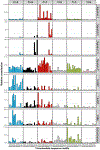Nitrated Polycyclic Aromatic Hydrocarbon (Nitro-PAH) Signatures and Somatic Mutations in Diesel Exhaust-Exposed Bladder Tumors
- PMID: 36996403
- PMCID: PMC10239365
- DOI: 10.1158/1055-9965.EPI-22-1208
Nitrated Polycyclic Aromatic Hydrocarbon (Nitro-PAH) Signatures and Somatic Mutations in Diesel Exhaust-Exposed Bladder Tumors
Abstract
Background: Diesel exhaust is a complex mixture, including polycyclic aromatic hydrocarbons (PAH) and nitrated PAHs (nitro-PAH), many of which are potent mutagens and possible bladder carcinogens. To explore the association between diesel exposure and bladder carcinogenesis, we examined the relationship between exposure and somatic mutations and mutational signatures in bladder tumors.
Methods: Targeted sequencing was conducted in bladder tumors from the New England Bladder Cancer Study. Using data on 797 cases and 1,418 controls, two-stage polytomous logistic regression was used to evaluate etiologic heterogeneity between bladder cancer subtypes and quantitative, lifetime estimates of respirable elemental carbon (REC), a surrogate for diesel exposure. Poisson regression was used to evaluate associations between REC and mutational signatures.
Results: We observed significant heterogeneity in the diesel-bladder cancer risk relationship, with a strong positive association among cases with high-grade, nonmuscle invasive TP53-mutated tumors compared with controls [ORTop Tertile vs.Unexposed, 4.8; 95% confidence interval (CI), 2.2-10.5; Ptrend < 0.001; Pheterogeneity = 0.002]. In muscle-invasive tumors, we observed a positive association between diesel exposure and the nitro-PAH signatures of 1,6-dintropyrene (RR, 1.93; 95% CI, 1.28-2.92) and 3-nitrobenzoic acid (RR, 1.97; 95% CI, 1.33-2.92).
Conclusions: The relationship between diesel exhaust and bladder cancer was heterogeneous based on the presence of TP53 mutations in tumors, further supporting the link between PAH exposure and TP53 mutations in carcinogenesis. Future studies that can identify nitro-PAH signatures in exposed tumors are warranted to add human data supporting the link between diesel and bladder cancer.
Impact: This study provides additional insight into the etiology and possible mechanisms related to diesel exhaust-induced bladder cancer.
©2023 American Association for Cancer Research.
Conflict of interest statement
Declarations: The authors declare no potential conflicts of interest.
Figures

References
-
- Silverman DT, Koutros S, Figueroa JD, Prokunina-Olsson L, Rothman N. Bladder Cancer. In: Thun MJ, Linet MS, Cerhan C, Haiman C, Schottenfelf D, editors. Schottenfeld and Fraumeni Cancer Epidemiology and Prevention. 4th ed. New York: Oxford University Press; 2018. p. 977–96.
-
- Boffetta P, Silverman DT. A Meta-Analysis of Bladder Cancer and Diesel Exhuast Exposure. Epidemiology. 2001;12:125–30. - PubMed
Publication types
MeSH terms
Substances
Grants and funding
LinkOut - more resources
Full Text Sources
Medical
Research Materials
Miscellaneous

